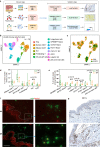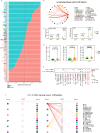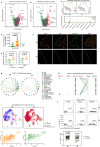Single-cell transcriptomics analysis of bullous pemphigoid unveils immune-stromal crosstalk in type 2 inflammatory disease
- PMID: 39009587
- PMCID: PMC11251189
- DOI: 10.1038/s41467-024-50283-3
Single-cell transcriptomics analysis of bullous pemphigoid unveils immune-stromal crosstalk in type 2 inflammatory disease
Abstract
Bullous pemphigoid (BP) is a type 2 inflammation- and immunity-driven skin disease, yet a comprehensive understanding of the immune landscape, particularly immune-stromal crosstalk in BP, remains elusive. Herein, using single-cell RNA sequencing (scRNA-seq) and in vitro functional analyzes, we pinpoint Th2 cells, dendritic cells (DCs), and fibroblasts as crucial cell populations. The IL13-IL13RA1 ligand-receptor pair is identified as the most significant mediator of immune-stromal crosstalk in BP. Notably, fibroblasts and DCs expressing IL13RA1 respond to IL13-secreting Th2 cells, thereby amplifying Th2 cell-mediated cascade responses, which occurs through the specific upregulation of PLA2G2A in fibroblasts and CCL17 in myeloid cells, creating a positive feedback loop integral to immune-stromal crosstalk. Furthermore, PLA2G2A and CCL17 contribute to an increased titer of pathogenic anti-BP180-NC16A autoantibodies in BP patients. Our work provides a comprehensive insight into BP pathogenesis and shows a mechanism governing immune-stromal interactions, providing potential avenues for future therapeutic research.
© 2024. The Author(s).
Conflict of interest statement
The authors declare no competing interest.
Figures







Similar articles
-
miR-1291 Functions as a Potential Serum Biomarker for Bullous Pemphigoid.Dis Markers. 2020 Jan 11;2020:9505312. doi: 10.1155/2020/9505312. eCollection 2020. Dis Markers. 2020. PMID: 32399091 Free PMC article.
-
A multi-hit hypothesis of bullous pemphigoid and associated neurological disease: Is HLA-DQB1*03:01, a potential link between immune privileged antigen exposure and epitope spreading?HLA. 2017 Mar;89(3):127-134. doi: 10.1111/tan.12960. Epub 2017 Jan 19. HLA. 2017. PMID: 28101965 Review.
-
Checkpoint Inhibition May Trigger the Rare Variant of Anti-LAD-1 IgG-Positive, Anti-BP180 NC16A IgG-Negative Bullous Pemphigoid.Front Immunol. 2019 Aug 14;10:1934. doi: 10.3389/fimmu.2019.01934. eCollection 2019. Front Immunol. 2019. PMID: 31474998 Free PMC article.
-
Reactivity against the BP180 ectodomain in patients with bullous pemphigoid, mucous membrane pemphigoid, multiple sclerosis and Parkinson disease.Exp Dermatol. 2024 Jul;33(7):e15125. doi: 10.1111/exd.15125. Exp Dermatol. 2024. PMID: 38946225
-
IgE-mediated mechanisms in bullous pemphigoid and other autoimmune bullous diseases.Expert Rev Clin Immunol. 2016;12(3):267-77. doi: 10.1586/1744666X.2016.1123092. Epub 2015 Dec 16. Expert Rev Clin Immunol. 2016. PMID: 26588556 Review.
Cited by
-
IL-27 as a novel biomarker for pruritus in nodular prurigo and bullous pemphigoid.Front Immunol. 2024 Dec 13;15:1499868. doi: 10.3389/fimmu.2024.1499868. eCollection 2024. Front Immunol. 2024. PMID: 39735535 Free PMC article.
-
Associated factors related to production of autoantibodies and dermo-epidermal separation in bullous pemphigoid.Arch Dermatol Res. 2025 Jan 24;317(1):303. doi: 10.1007/s00403-024-03760-0. Arch Dermatol Res. 2025. PMID: 39853516 Review.
-
Bullous pemphigoid.Nat Rev Dis Primers. 2025 Feb 20;11(1):12. doi: 10.1038/s41572-025-00595-5. Nat Rev Dis Primers. 2025. PMID: 39979318 Review.
-
Therapeutic targeting of alternative pathway and C5 but not C5a protects from disease development in a preclinical model of autoimmune blistering dermatosis.Front Immunol. 2025 Apr 30;16:1560468. doi: 10.3389/fimmu.2025.1560468. eCollection 2025. Front Immunol. 2025. PMID: 40370446 Free PMC article.
-
Recent advances in the genetics and innate immune cells of bullous pemphigoid.Front Immunol. 2025 Jun 18;16:1530407. doi: 10.3389/fimmu.2025.1530407. eCollection 2025. Front Immunol. 2025. PMID: 40607386 Free PMC article. Review.
References
MeSH terms
Substances
LinkOut - more resources
Full Text Sources
Medical

